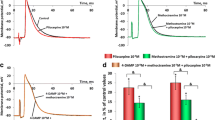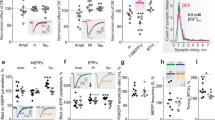Summary
The question whether presynaptic α2-adrenoceptors regulating noradrenaline release in hippocampus directly couple to tetraethylammonium chloride (TEA) or α-dendrotoxin (α-DTX)-sensitive K+ channels was investigated. Hippocampal slices, prelabelled with [3H] noradrenaline, were superfused in the presence of (+)-oxaprotiline and electrically stimulated with 4 pulses delivered at 100 Hz, in order to avoid autoinhibition due to released noradrenaline.
TEA enhanced the evoked [3H]noradrenaline release in rabbit hippocampus in a concentration-dependent manner, yielding an approximately 4-fold increase at 30 mmol/l, whereas the spontaneous outflow of tritium was only slightly affected at this concentration. The α2-adrenoceptor agonist clonidine, at 10–100 nmol/l inhibited the evoked [3H]noradrenaline release between 77% and 96%. The inhibitory effect of the α2-agonist was distinctly diminished in the presence of 30 mmol/l TEA but was restored in low Ca2+/high Mg2+ buffer. Therefore, the diminution of the α2-agonist effect by TEA observed in experiments with normal Ca2+ can be explained by an increase of the Ca2+ availability for the release process due to the prolongation of action potentials. In rabbit hippocampus α-DTX (10–200 nmol/l) did neither affect the evoked release of [3H]noradrenaline nor its α2-agonist-induced modulation. However, in rat hippocampus α-DTX significantly increased the evoked transmitter release and diminished the effect of clonidine.
Taken together, the present data for the rabbit hippocampus exclude the possibility that activation of presynaptic α2-adrenoceptors inhibits depolarization-evoked [3H]noradrenaline release by inducing an outward K+ current through TEA- or α-DTX-sensitive K+ channels. However, there are species differences between the rabbit and the rat so that in the rat the α2-adrenoceptors could actually be coupled to K+ channels — provided that the release-enhancing properties of α-DTX do not account for the α2-antagonism observed.
Similar content being viewed by others
References
Aghajanian GK, Wang YY (1986) Pertussis toxin blocks the outward currents evoked by opiate and α2-agonists in locus coeruleus neurons. Brain Res 371:390–394
Allgaier C, Feuerstein TJ, Jackisch R, Hertting G (1985) Isletactivating protein (pertussis toxin) diminishes α2-adrenoceptor mediated effects on noradrenaline release. Naunyn-Schmiedeberg's Arch Pharmacol 331:235–239
Allgaier C, Feuerstein TJ, Hertting G (1986) N-ethyhnaleimide (NEM) diminishes α2-adrenoceptor mediated effects on noradrenaline release. Naunyn-Schmiedeberg's Arch Pharmacol 333:104–109
Allgaier C, Daschmann B, Sieverling J, Hertting G (1989) Presynaptic κ-opioid receptors on noradrenergic nerve terminals couple to G proteins and interact with the α2-adrenoceptors. J Neurochem 53:1629–1635
Allgaier C, Greber R, Hertting G (1991a) Studies on the interaction between presynaptic α2-adrenoceptors and adenosine A1 receptors located on noradrenergic nerve terminals. Naunyn-Schmiedeberg's Arch Pharmacol 344:187–192
Allgaier C, Hertting G, Singer EA (1991b) A detailed study on the effects of protein kinase C activation on α2-adrenoceptor-coupled modulation of norepinephrine release in hippocampus. J Pharmacol Exp Ther 258:143–148
Allgaier C, Agneter E, Feuerstein TJ, Singer EA (1992) Estimation of the biophase concentration of noradrenaline at presynaptic α2-adrenoceptors in brain slices. Naunyn-Schmiedeberg's Arch Pharmacol 345:402–409
Castle NA, Haylett DG, Jenkinson DH (1989) Toxins in the characterization of potassium channels. Trends Neurosci 12:59–65
Chesselet M-F (1984) Presynaptic regulation of neurotransmitter release in the brain: facts and hypothesis. Neuroscience 12:347–375
Cook NS (1988) The pharmacology of potassium channels and their therapeutic potential. Trends Pharmacol Sci 9:21–28
Drukarch B, Kits KS, Leysen JE, Schepens E, Stoof JC (1989) Restricted usefulness of tetraethylammonium and 4-amino-pyridine for the characterization of receptor-operated K+ channels. Br J Pharmacol 98:113–118
Harvey AL, Karlsson E (1980) Dendrotoxin from the venom of the green mamba, Dendroaspis angusticeps. A neurotoxin that enhances acetylcholine release at neuromuscular junctions. Naunyn-Schmiedeberg's Arch Pharmacol 312:1–6
Hu P-S, Fredhohn BB (1991) 4-Aminopyridine-induced increase in basal and stimulation-evoked [3H]-NA release in slices from rat hippocampus: Ca2+ sensitivity and presynaptic control. Br J Pharmacol 102:764–768
Hu P-S, Benishin C, Fredhohn BB (1991) Comparison of the effects of four dendrotoxin peptides, 4-aminopyridine and tetraethylammonium on the electrically evoked [3H]noradrenaline release from rat hippocampus. Eur J Pharmacol 209:87–93
Huang HY, Hertting G, Allgaier C, Jackisch R (1989) 3,4-Diaminopyridine-induced noradrenaline release from CNS tissue as a model for action potential-evoked transmitter release: effects of phorbol ester. Eur J Pharmacol 169:115–123
Huang HY, Hertting G, Allgaier C, Jackisch R (1991) 3,4-Diaminopyridine-evoked noradrenaline release in rat hippocampus: role of Na+ entry on Ca2+ pools and of protein kinase C. Eur J Pharmacol — Mol Pharmacol Sect 206:221–230
Illes P (1986) Mechanisms of receptor-mediated modulation of transmitter release in noradrenergic, cholinergic and sensory neurones. Neuroscience 17:909–928
Illes P, Dörge L (1985) Mechanism of α2-adrenergic inhibition of neuroeffector transmission in the mouse vas deferens. Naunyn-Schmiedeberg's Arch Pharmacol 328:241–247
Jackisch R, Huang HY, Rensing H, Lauth D, Allgaier C, Hertting C (1992) α2-Adrenoceptor mediated inhibition of exocytotic noradrenaline release in the absence of extracellular Ca2+. Eur J Pharmacol — Mol Pharmacol Sect 226:245–252
Langer SZ (1981) Presynaptic regulation of the release of catecholamines. Pharmacol Rev 32:337–362
Limberger N, Mayer A, Zier G, Valenta B, Starke K, Singer EA (1989) Estimation of pA2 values at presynaptic α2-autoreceptors in rabbit and rat brain cortex in the absence of autoinhibition. Naunyn-Schmiedeberg's Arch Pharmacol 340:639–647
Mulder AH, Schoffelmeer ANM, Stoof JC (1990) On the role of adenylate cyclase in presynaptic modulation of neurotransmitter release mediated by monoamine and opioid receptors in the brain. In: Kalsner S, Westfall TC (eds) Presynaptic receptors and the question of autoregulation of neurotransmitter release. Ann NY Acad Sci 604:237–249
Rudy B (1988) Diversity and ubiquity of K+ channels. Neuroscience 25:729–749
Schoffelmeer ANM, Mulder AH (1983) Differential control of Ca2+-dependent [3H]Noradrenaline release from rat brain slices through presynaptic opiate receptors and α-adrenoceptors. Eur J Pharmacol 87:449–458
Singer EA (1988) Transmitter release from brain slices elicited by single pulses: a powerful method to study presynaptic mechanisms. Trends Pharmacol Sci 9:274–276
Starke K, Göthert M, Kilbinger H (1989) Modulation of neurotransmitter release by presynaptic autoreceptors. Physiol Rev 69:864–989
Stjärne L (1978) Facilitation and receptor-mediated regulation of noradrenaline secretion by control of recruitment of varicosities as well as by control of electro-secretory coupling. Neuroscience 3:1147–1155
Wakade AR, Wakade TD (1983) Mechanism of negative feed-back inhibition of norepinephrine release by alpha-adrenergic agonists. Neuroscience 9:673–677
Waldmeier PC, Baumann PA, Hauser K, Maitre L, Storni A (1982) Oxaprotiline, a noradrenaline uptake inhibitor with an active and an inactive enantiomer. Biochem Pharmacol 31:2169–2176
Wemer J, Schoffelmeer ANM, Mulder AH (1981) Studies on the role of Na+, K+ and Cl− ion permeabilities in K+-induced release of 3H-noradrenaline from rat brain slices and synaptosomes and in its presynaptic α-adrenergic modulation. Naunyn-Schmiedeberg's Arch Pharmacol 317:103–109
Williams JT, Henderson G, North RA (1985) Characterization of α2-adrenoceptors which increase potassium conductance in rat locus coeruleus neurones. Neuroscience 14:95–101
Author information
Authors and Affiliations
Additional information
Correspondence to C. Allgaier at the above address
Rights and permissions
About this article
Cite this article
Allgaier, C., Repp, H. & Hertting, G. Effect of K+ channel blockers on the α2-adrenoceptor-coupled regulation of electrically evoked noradrenaline release in hippocampus. Naunyn-Schmiedeberg's Arch Pharmacol 347, 14–20 (1993). https://doi.org/10.1007/BF00168766
Received:
Accepted:
Issue Date:
DOI: https://doi.org/10.1007/BF00168766




